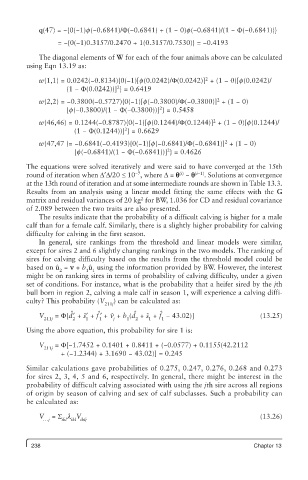Page 254 - Linear Models for the Prediction of Animal Breeding Values 3rd Edition
P. 254
q(47) = −{0(−1)f(−0.6841)/F(−0.6841) + (1 − 0)f(−0.6841)/(1 − F(−0.6841))}
= −{0(−1)0.3157/0.2470 + 1(0.3157/0.7530)} = −0.4193
The diagonal elements of W for each of the four animals above can be calculated
using Eqn 13.19 as:
2
w(1,1) = 0.0242(−0.8134){0(−1)[f(0.0242)/F(0.0242)] + (1 − 0)[f(0.0242)/
2
(1 − F(0.0242))] } = 0.6419
2
w(2,2) = −0.3800(−0.5727){0(−1)[f(−0.3800)/F(−0.3800)] + (1 − 0)
2
[f(−0.3800)/(1 − F(−0.3800))] } = 0.5458
2
w(46,46) = 0.1244(−0.8787){0(−1)[f(0.1244)/F(0.1244)] + (1 − 0)[f(0.1244)/
2
(1 − F(0.1244))] } = 0.6629
2
w(47,47 )= −0.6841(−0.4193){0(−1)[f(−0.6841)/F(−0.6841)] + (1 − 0)
2
[f(−0.6841)/(1 − F(−0.6841))] } = 0.4626
The equations were solved iteratively and were said to have converged at the 15th
round of iteration when Δ′Δ/20 £ 10 , where Δ = q − q (i−1) . Solutions at convergence
(i)
−7
at the 13th round of iteration and at some intermediate rounds are shown in Table 13.3.
Results from an analysis using a linear model fitting the same effects with the G
2
matrix and residual variances of 20 kg for BW, 1.036 for CD and residual covariance
of 2.089 between the two traits are also presented.
The results indicate that the probability of a difficult calving is higher for a male
calf than for a female calf. Similarly, there is a slightly higher probability for calving
difficulty for calving in the first season.
In general, sire rankings from the threshold and linear models were similar,
except for sires 2 and 6 slightly changing rankings in the two models. The ranking of
sires for calving difficulty based on the results from the threshold model could be
ˆ
based on u = n + b uˆ using the information provided by BW. However, the interest
2 1 1
might be on ranking sires in terms of probability of calving difficulty, under a given
set of conditions. For instance, what is the probability that a heifer sired by the jth
bull born in region 2, calving a male calf in season 1, will experience a calving diffi-
culty? This probability (V ) can be calculated as:
211j
ˆ
ˆ
ˆ
ˆ
ˆ
ˆ
V = F[d′ + s′ + f ′ + n + b (d + s + f − 43.02)] (13.25)
ˆ
211j 2 1 1 j 1 2 1 1
Using the above equation, this probability for sire 1 is:
V = F[−1.7452 + 0.1401 + 0.8411 + (−0.0577) + 0.1155(42.2112
211j
+ (−1.2344) + 3.1690 − 43.02)] = 0.245
Similar calculations gave probabilities of 0.275, 0.247, 0.276, 0.268 and 0.273
for sires 2, 3, 4, 5 and 6, respectively. In general, there might be interest in the
probability of difficult calving associated with using the jth sire across all regions
of origin by season of calving and sex of calf subclasses. Such a probability can
be calculated as:
V = S l V (13.26)
...j ikl ikl iklj
238 Chapter 13

